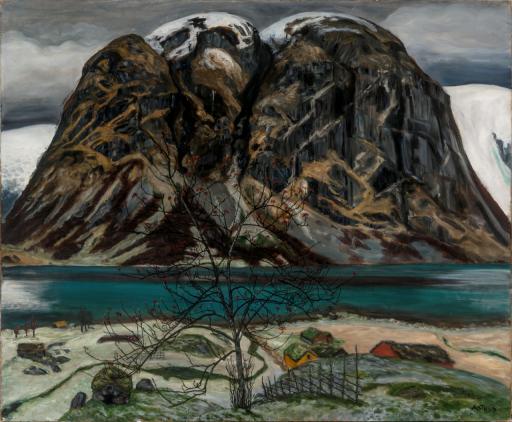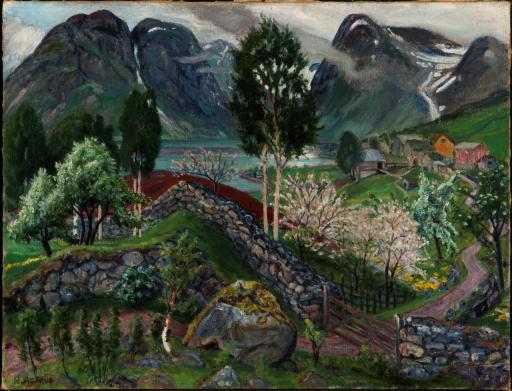Provenance
-1919-1922:
Artist
Nikolai Astrup
(1880-1928)
1922-1926:
Purchased by
Conrad Mohr
(1849-1926)
1926-1957:
By descent, to
Aslaug Mohr
(1879-1959)
1957-1991:
Gift to
Kong Olav V
(1903-1991)
1957-current:
De kongelige samlinger
1957-current:
Det kongelige hoff
Exhibition history
Solo exhibition
1928-11-11 - 1928-12-9
Nikolai Astrup. Mindeutstilling
Kristiania (Oslo)
Catalogue number 88
See exhibition
1986-6-21 - 1986-8-15
Nikolai Astrup. Naturkjensle mot industrisamfunnet
Sandalstrand, Jølster
Catalogue number 21
See exhibition
Group exhibition
Bibliography
Bergens Kunstforening. Nikolai Astrup 1880–1928. Mindeutstilling. Bergen: Bergens kunstforening, 1928.
Loge, Øystein. Betrothed to Nature. Oslo: Det Norske Samlaget, 2010.
Gløersen, Inger Alver. Nikolai Astrup. Oslo: Gyldendal, 1967 [1954].
Gløersen, Inger Alver. Nikolai Astrup. Oslo: Mittet & co. Forlag, 1954.
Loge, Øystein. Gartneren under regnbuen. Hjemstavnskunstneren Nikolai Astrup. Oslo: Dreyers Forlag, 1990 [1986].
Lexow, Einar. «Nikolai Astrup». Kunst og kultur 15, (1928): 193–212.
Storaas, Reidar. «Kunstnarvener: Nikolai Astrup». In Vestlandskunstnaren Mons Breidvik, ed.: Storaas, Reidar, 25–43. Førde: Selja Forlag AS, 2000.
Lofnes, Solveig Berg. Nikolai Astrup og Jølster. Førde: Selja Forlag AS, 2016.
Loge, Øystein. Nikolai Astrup. Elskaren under trekrona. Oslo: Det Norske Samlaget, 2005.
Følstad, Sverre, Sandra Lorentzen og Tone Sinding Steinsvik. Mellom to verdener. Mystikk og myter i norsk kunst 1850-1950. Drammen: Stiftelsen Modums Blaafarveværk, 2022.

